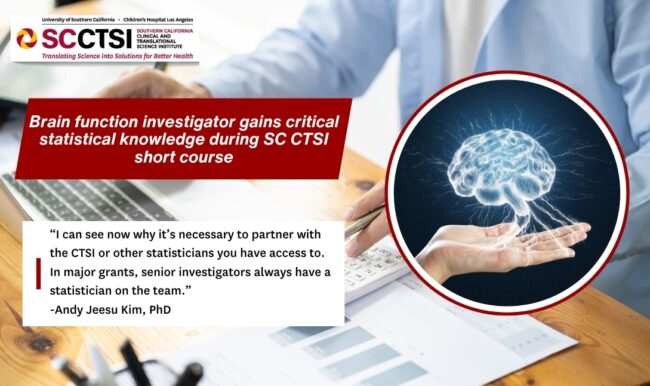Brain function investigator gains critical statistical knowledge during SC CTSI short course
SC CTSI program helps early-career researchers sharpen grant-proposal and statistical-analysis skills
Could studying the human eye help scientists diagnose ailments of the aging brain? To answer this question, Andy Jeesu Kim, PhD, a neuropsychologist and postdoctoral scholar in gerontology at the USC Leonard Davis School of Gerontology, is employing eye tracking technology, MRI scans and other methods to test brain function in older people. His goal is to spot early markers and progression of neurodegenerative diseases such as Alzheimer’s by identifying subtle declines in eye movement speed during problem-solving tests.
But to understand such
cognitive changes, Kim needed a deeper knowledge of comprehensive research
design, advanced statistical analysis and biostatistician mentoring.
“I realized I didn’t have all
of the statistical training I wanted,” he said.
To advance his statistical
skills, Kim applied for an invitation-only training program, “Developing your
Grant Proposal: Biostatistics and Research Design Principles,” offered in
January 2024 by the Southern California Clinical and Translational Science Institute
Biostatistics, Epidemiology, and Research Design (SC CTSI BERD) core.

The six-month program consists
of biweekly short modules with a workshop component involving fellow trainees,
focusing on developing a document such as a grant draft or research protocol.
Kim was the only non-clinician in his cohort.
In Kim’s research
experiments, participants look at a computer screen and perform tasks such as
identifying shapes.
“As people grow older,
performing these tasks becomes slower, and you make more mistakes in
identifications,” he said.
Participants’ eye movements
could provide clues to disruption in the brain’s locus coeruleus. This part of
the brain stem produces norepinephrine, a neurotransmitter. Damage to the locus
coeruleus is implicated in depression, cognitive difficulties, Alzheimer’s and
other kinds of dementia.
“Dysfunctions of locus
coeruleus can directly impact the timing of problem-solving,” said Kim. “By
identifying a 10-millisecond difference in speed, we can say whether your brain
is getting slower.”
The SC CTSI course allowed
Kim to work through many study-design options for longitudinal clinical trials
in Kim’s neuropsychological research.
“Should we blind the
participants? Should the experimenter be blinded? Should it be a double-blind
clinical trial? Should we have our intervention within subjects or between
subjects? All factors are analyzed through statistics as we decide which design
to use,” added Kim.
In the short course, Kim and
other trainees developed a specific, testable set of research questions and
aim; identified a funding mechanism and created a corresponding tailored
proposal; determined the best study design and method of analysis; explained
methodological considerations, including the management and analysis of data;
anticipated and responded to common pitfalls made in a grant application; and
effectively wrote and presented preliminary results.
Trainees learned the
importance of consulting with a statistician early in the research process to
ensure a successful study design plan. Errors in research design are the most
common flaw in submitted manuscripts, resulting in rejection.
“I can see now why it’s
necessary to partner with the CTSI or other statisticians you have access to,”
said Kim. “In major grants, senior investigators always have a statistician on
the team.”
When Kim began the training
program, he was already working on a K99/R00 BERD grant proposal and knew he
needed more grant-writing guidance.
These grants support new NIH-supported,
independent investigators, facilitating a transition of postdoctoral
researchers or clinician-scientists from mentored research positions to
independent, tenure-track or equivalent faculty positions.
Wendy Mack, PhD, director of
the BERD core, was Kim’s training program mentor, helping him identify and
recruit a research team, assist with crucial sections of the grant and other
guidance.
Kim also met with his faculty
mentor, Trevor Pickering, PhD, a biostatistician faculty member with SC CTSI,
between biweekly sessions.
“We would talk about broad
concepts in the cohort sessions,” Kim said. “In discussions with my mentor, I
could apply those broad concepts directly to my grant proposal.”
Workshops with fellow
trainees helped sharpen his writing, giving him feedback to improve his skills.
“I was proposing my ideas to
people who aren’t in my field and using language unfamiliar to them,” Kim said.
“I needed more practice writing for a broader audience.”
The training also provided
invaluable practical information about presenting his approach to expert
reviewers.
“I would write something that
I thought would be sufficient, but my mentors would tell me that I had to
provide more information,” Kim said. “I learned how to say what I want to say
in a way that the grant agency needs to receive it.”



